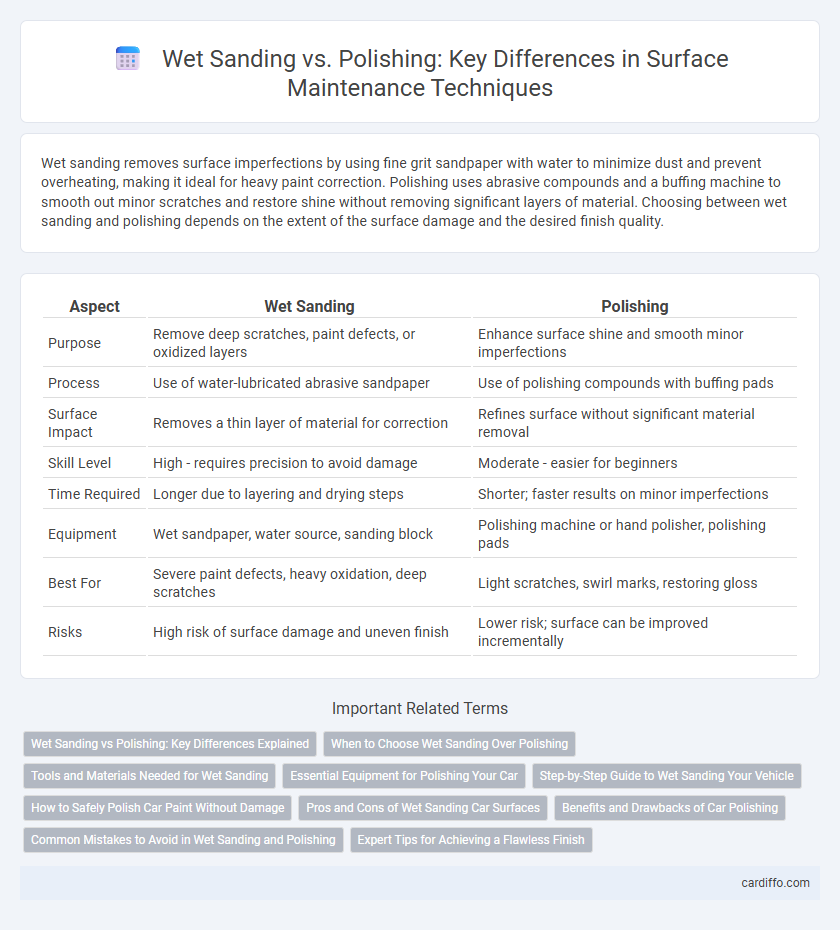Wet sanding removes surface imperfections by using fine grit sandpaper with water to minimize dust and prevent overheating, making it ideal for heavy paint correction. Polishing uses abrasive compounds and a buffing machine to smooth out minor scratches and restore shine without removing significant layers of material. Choosing between wet sanding and polishing depends on the extent of the surface damage and the desired finish quality.
Table of Comparison
| Aspect | Wet Sanding | Polishing |
|---|---|---|
| Purpose | Remove deep scratches, paint defects, or oxidized layers | Enhance surface shine and smooth minor imperfections |
| Process | Use of water-lubricated abrasive sandpaper | Use of polishing compounds with buffing pads |
| Surface Impact | Removes a thin layer of material for correction | Refines surface without significant material removal |
| Skill Level | High - requires precision to avoid damage | Moderate - easier for beginners |
| Time Required | Longer due to layering and drying steps | Shorter; faster results on minor imperfections |
| Equipment | Wet sandpaper, water source, sanding block | Polishing machine or hand polisher, polishing pads |
| Best For | Severe paint defects, heavy oxidation, deep scratches | Light scratches, swirl marks, restoring gloss |
| Risks | High risk of surface damage and uneven finish | Lower risk; surface can be improved incrementally |
Wet Sanding vs Polishing: Key Differences Explained
Wet sanding involves using water to lubricate the surface while sanding with fine-grit sandpaper, effectively removing deep scratches or oxidation from automotive paint. Polishing uses abrasive compounds and a buffer to smooth and enhance the paint's gloss after defects have been leveled by sanding. The key difference lies in wet sanding's ability to correct severe imperfections by material removal, whereas polishing primarily restores shine and refines minor surface flaws.
When to Choose Wet Sanding Over Polishing
Wet sanding is ideal when removing deep scratches, oxidation, or severe paint imperfections requiring aggressive surface leveling before polishing. It is best chosen for preparing clear coats or painted surfaces that need significant correction without generating excessive dust or heat. Polishing is more suitable for minor surface defects and enhancing gloss, while wet sanding targets foundational imperfections that polishing alone cannot address.
Tools and Materials Needed for Wet Sanding
Wet sanding requires specific tools including waterproof sandpaper with grit ranging from 1000 to 3000, a sanding block for even pressure, and a bucket of water or a spray bottle to keep the surface wet during sanding. Using water as a lubricant is essential to prevent clogging the sandpaper and reduce heat generated, which protects the paint or finish. Specialized materials like clay bars or polishing compounds often follow wet sanding to restore surface smoothness and enhance shine.
Essential Equipment for Polishing Your Car
Essential equipment for polishing your car includes a dual-action polisher, polishing pads of varying abrasiveness, and high-quality polishing compounds designed to remove swirl marks and restore paint clarity. A foam polishing pad offers flexibility for even application, while microfiber towels ensure a streak-free finish. Using these tools properly enhances paint smoothness and overall vehicle appearance, significantly elevating the car's aesthetic value.
Step-by-Step Guide to Wet Sanding Your Vehicle
Start by thoroughly washing and drying your vehicle to remove any dirt or debris that could cause scratches during wet sanding. Use a high-quality wet sandpaper with a grit between 1500 and 3000, soak it in water for at least 30 minutes, and sand gently in a back-and-forth motion on the damaged area while keeping the surface wet. After sanding, polish the area with a dual-action polisher and a fine polishing compound to restore the paint's shine and smoothness.
How to Safely Polish Car Paint Without Damage
Wet sanding removes minor imperfections by using fine-grit sandpaper and water to gently smooth car paint, but must be done cautiously to avoid paint thinning. Polishing restores shine and removes light scratches through abrasive compounds and a buffer, requiring the correct pad and polish type for the specific paint finish. To safely polish car paint without damage, always clean the surface thoroughly, use a dual-action polisher at low speeds, and apply polish in thin, even layers while avoiding excessive pressure.
Pros and Cons of Wet Sanding Car Surfaces
Wet sanding car surfaces effectively removes deep scratches, oxidation, and paint imperfections, resulting in a smooth and even finish. However, it requires careful technique and constant water lubrication to prevent further damage or swirl marks on the paint. While wet sanding can significantly improve surface quality, it is labor-intensive and may strip clear coat layers if not performed correctly.
Benefits and Drawbacks of Car Polishing
Car polishing enhances paint gloss and removes minor scratches, oxidation, and swirl marks, restoring the vehicle's aesthetic appeal. However, excessive polishing can thin the clear coat, increasing the risk of paint damage and requiring careful application by skilled professionals. Compared to wet sanding, polishing is less aggressive but may not effectively correct deep imperfections or major surface defects.
Common Mistakes to Avoid in Wet Sanding and Polishing
Common mistakes in wet sanding include using too coarse grit paper, applying uneven pressure, and not keeping the surface adequately lubricated, which can cause deep scratches and damage the paint. In polishing, avoid using excessive speed, applying too much product, or skipping proper surface cleaning to prevent swirl marks and holograms. Proper technique and material selection are essential for achieving a smooth, flawless finish during maintenance.
Expert Tips for Achieving a Flawless Finish
Wet sanding removes scratches and imperfections more effectively than polishing alone by using fine-grit sandpaper with water to minimize dust and heat. Experts recommend starting with high-grit wet sandpaper (1500-3000 grit) followed by a specialized polishing compound to restore shine and clarity. Consistent, gentle pressure and proper lubrication during wet sanding prevent surface damage, resulting in a smooth, flawless finish.
Wet Sanding vs Polishing Infographic

 cardiffo.com
cardiffo.com